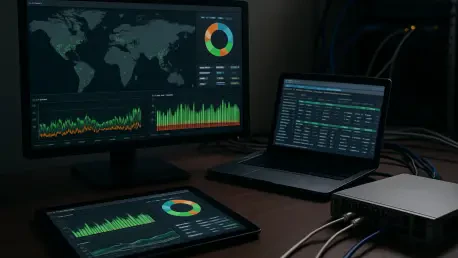In an era where digital connectivity underpins nearly every aspect of business operations, ensuring the seamless performance of networks has become a critical priority for organizations of all sizes. As hybrid cloud environments, remote work setups, and intricate IT infrastructures grow more common, network monitoring tools have emerged as indispensable allies for IT teams tasked with maintaining uptime, security, and efficiency. These solutions provide real-time insights into the health of routers, switches, servers, and applications, empowering businesses to address potential disruptions before they spiral into costly outages. With the stakes higher than ever, selecting the right tool can mean the difference between a resilient network and a vulnerable one. This article delves into the leading network monitoring solutions shaping the landscape today, exploring their standout features, innovative trends, and suitability for diverse needs. From cutting-edge AI-driven platforms to cost-effective open-source options, the focus is on what sets these tools apart and how they cater to the evolving demands of modern enterprises. By examining key aspects like scalability, usability, and deployment flexibility, this comprehensive guide aims to equip IT professionals with the knowledge needed to make informed decisions in a crowded market.
The Critical Role of Network Monitoring Today
Network monitoring has evolved from a nice-to-have feature into a cornerstone of business continuity in today’s interconnected world. With organizations increasingly reliant on cloud services, distributed systems, and remote access, the ability to maintain full visibility across an entire IT ecosystem is paramount. These tools enable IT teams to detect performance bottlenecks, identify security threats, and ensure that critical systems remain operational, all while minimizing downtime that could derail productivity or damage reputation. The complexity of modern networks, spanning on-premise hardware to multi-cloud environments, underscores the necessity of robust monitoring solutions that can keep pace with rapid technological shifts.
Beyond simply observing network activity, the latest tools are designed to anticipate issues before they manifest into larger problems. By providing detailed analytics and automated alerts, they allow businesses to shift from a reactive stance to a proactive one, addressing vulnerabilities in real time. This capability is especially vital in an environment where even a brief service interruption can result in significant financial losses or customer dissatisfaction. As digital transformation accelerates, the reliance on comprehensive monitoring solutions becomes not just a technical requirement but a strategic imperative for maintaining competitive edge and operational stability.
Essential Features Defining Top Tools
When evaluating network monitoring solutions, certain core functionalities stand out as non-negotiable for ensuring effective oversight of IT infrastructure. Real-time tracking remains a fundamental feature, offering immediate updates on network health across devices, applications, and servers, which is crucial for swift decision-making. Automated device discovery and detailed dashboards further enhance visibility, enabling IT teams to map out their entire network and spot irregularities at a glance. These foundational elements ensure that businesses, whether small startups or global enterprises, can maintain a clear understanding of their systems’ performance without being overwhelmed by data.
Additionally, the integration of advanced capabilities sets the leading tools apart in a competitive field. Features such as customizable reporting and alert thresholds allow for tailored monitoring that aligns with specific organizational goals, reducing unnecessary noise and focusing on critical issues. Compatibility with diverse environments, from legacy setups to modern cloud platforms, is another key consideration, ensuring that a tool remains relevant as infrastructure evolves. The emphasis on these sophisticated yet practical features reflects a broader industry trend toward solutions that not only monitor but also empower teams to optimize their networks with precision and efficiency.
Harnessing AI and Automation for Smarter Insights
One of the most transformative developments in network monitoring is the adoption of artificial intelligence and machine learning to enhance operational efficiency. These technologies enable tools to go beyond traditional monitoring by detecting anomalies, predicting potential failures, and even automating remediation processes. This shift significantly reduces the burden on IT staff, who often grapple with alert fatigue in complex environments, allowing them to focus on strategic initiatives rather than constant firefighting. The result is a more streamlined approach to managing networks that are growing in both scale and intricacy.
Tools leveraging AI-driven insights are particularly adept at cutting through the clutter of vast data streams, identifying root causes of issues with remarkable speed and accuracy. This capability is invaluable in large-scale or hybrid setups where manual analysis would be impractical. By automating routine tasks and offering predictive analytics, these solutions help organizations stay ahead of disruptions, ensuring smoother operations and better resource allocation. As AI continues to mature, its integration into network monitoring platforms signals a future where human oversight is complemented by intelligent systems, redefining how IT challenges are addressed.
Scalability to Support Business Expansion
For businesses experiencing growth or navigating diverse operational landscapes, scalability in network monitoring tools is a critical factor. The ability to manage an increasing number of devices, users, and locations without compromising performance is essential for organizations aiming to expand their footprint. Top solutions are engineered to handle vast networks, whether they span multiple office sites or incorporate cloud-based resources, ensuring that monitoring capabilities grow in tandem with business needs. This adaptability prevents the need for frequent tool replacements as infrastructure scales.
Moreover, scalability extends beyond mere numbers to include flexibility across different types of environments. Leading tools excel in supporting hybrid setups, seamlessly integrating with both traditional on-premise systems and modern cloud architectures. This ensures that businesses undergoing digital transformation or operating in mixed environments are not left with gaps in oversight. By prioritizing scalable design, these solutions provide a future-proof foundation, allowing IT teams to focus on innovation rather than worrying about outgrowing their monitoring capabilities. This focus on accommodating growth reflects the dynamic nature of today’s corporate landscapes.
Striking a Balance Between Usability and Functionality
Ease of use remains a pivotal consideration for many organizations when selecting network monitoring tools, particularly for those with limited technical expertise or smaller IT teams. Solutions that offer intuitive interfaces and straightforward setup processes can significantly lower the barrier to effective monitoring, making them ideal for small to medium-sized businesses. The ability to quickly deploy and navigate a tool without extensive training ensures that even resource-constrained teams can maintain robust oversight of their networks, preventing issues from slipping through the cracks.
Conversely, for larger enterprises or specialized IT departments, the depth of functionality often takes precedence over simplicity. Advanced customization options, detailed analytics, and granular control are vital for addressing complex requirements, even if they come with a steeper learning curve. The most effective tools strike a balance, offering scalable interfaces that cater to both novice users and seasoned professionals. This dual focus ensures that businesses of varying sizes and technical capabilities can find value, whether they prioritize plug-and-play simplicity or comprehensive, hands-on management of their network environments.
Deployment Flexibility and Budget Alignment
The diversity of deployment options available in network monitoring tools reflects the varied preferences and security needs of modern organizations. On-premise installations continue to appeal to businesses seeking maximum control over their data and infrastructure, providing a sense of ownership and customization that aligns with strict compliance requirements. Meanwhile, cloud-based solutions, often delivered as Software-as-a-Service (SaaS), offer unparalleled accessibility and scalability, making them a popular choice for companies with distributed teams or those prioritizing ease of updates and maintenance.
Cost considerations also play a significant role in decision-making, with pricing models ranging from free open-source platforms to premium enterprise subscriptions. Mid-range tools often provide a compelling balance, delivering robust feature sets without the hefty price tags associated with high-end solutions. This variety ensures that organizations can align their choice with budgetary constraints while still accessing critical monitoring capabilities. Whether opting for a cost-free option requiring more hands-on configuration or investing in a comprehensive paid platform, the flexibility in deployment and pricing allows for tailored solutions that match specific operational and financial priorities.
Tailored Solutions for Niche Requirements
Recognizing that not all businesses face identical challenges, many leading network monitoring tools are designed with specific audiences and use cases in mind. Some are crafted for managed service providers who oversee multiple client networks, offering features like automated mapping and multi-site management to streamline their unique workflows. Others cater to DevOps teams, integrating seamlessly with development pipelines and emphasizing full-stack observability to support rapid iteration and deployment in fast-paced environments.
This specialization ensures that niche pain points are addressed directly, rather than forcing organizations to adapt to generic solutions. For instance, tools focused on deep traffic analysis or specific compliance needs provide targeted value that broader platforms might overlook. By honing in on particular sectors or operational models, these solutions help IT professionals select a tool that feels custom-built for their challenges, maximizing efficiency and relevance. This trend toward tailored offerings highlights the industry’s acknowledgment of diverse needs, ensuring that even highly specialized requirements find a fitting match in today’s market.
Charting the Path Forward for Network Monitoring
Reflecting on the landscape of network monitoring, it becomes evident that the tools available have reached new heights in addressing the multifaceted demands of digital infrastructure. Their ability to provide real-time visibility, harness AI for predictive insights, and scale across sprawling environments has fundamentally changed how businesses safeguard their operations. Each solution, whether tailored for small teams or vast enterprises, plays a pivotal role in minimizing disruptions and enhancing security across varied setups.
Looking ahead, the next steps for IT leaders involve a careful evaluation of their specific needs against the strengths of these tools. Prioritizing factors such as integration with existing systems, anticipated growth, and budget constraints will guide the selection process toward a solution that drives long-term value. Additionally, staying attuned to emerging innovations, particularly in automation and cloud compatibility, will ensure that chosen tools remain relevant as technology advances. By aligning strategic goals with the right monitoring platform, organizations can build a resilient foundation for navigating the complexities of tomorrow’s digital challenges.









